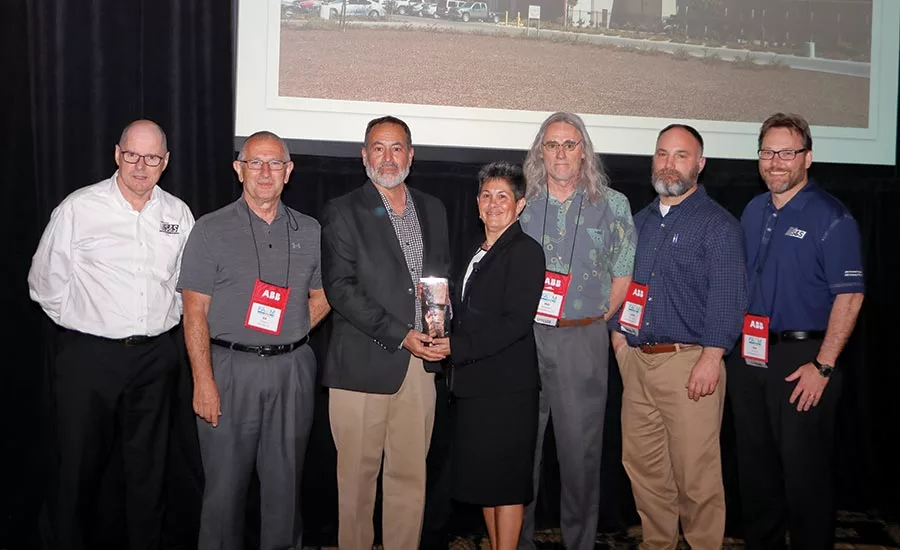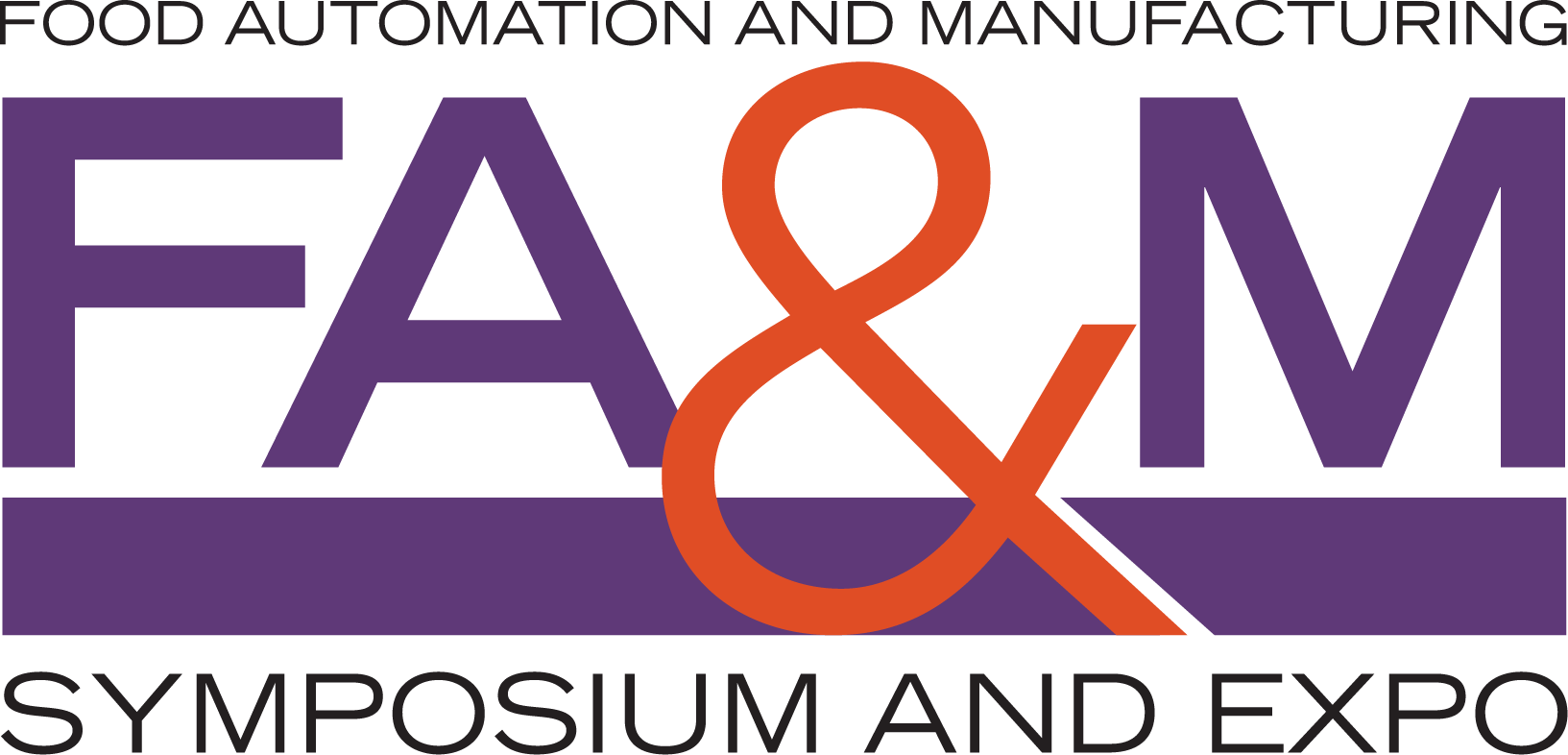FA&M Recap
FA&M gathers food processors and suppliers together for education and exhibits

In the Miami sunshine, processors and suppliers take advantage of abundant time for casual conversations at FA&M.

Valley Milk CEO Patti Smith, Valley Milk employees and representatives from Shambaugh & Son accepted the 2019 Food Engineering Plant of the Year award.

A panel discussion of women in food manufacturing focused on the challenges women face and how the industry can get more girls and young women interested in technical and engineering careers.
Welcome to the new FA&M report, our coverage of the 20th annual Food Automation & Manufacturing Conference, Food Engineering’s premier event.
This year’s FA&M got off to memorable start, as bad weather over the weekend complicated travel for a number of attendees and guests, with that topic dominating conversation at the welcome reception. But the first morning of the conference kicked off with a great keynote address from Tyson’s Anthony Doss, and attendees spent the next 2½ days enjoying the speakers and exhibitors who made the show a success.
Following this report, all the companies that exhibited are listed. Enjoy this recap, and we hope to see you at FA&M in 2020.
Jump To:
The Food Plant of the Future
The first speaker of the event was Anthony Doss, vice president-engineering, poultry at Tyson. In his keynote address, Doss addressed the role of engineering in building the food plant of the future.
Processors face an ongoing challenge to hire and keep qualified people, and that challenge is especially pronounced when it comes to skilled labor positions such as engineers. There are literally more jobs than there are people to fill them, and engineers or other employees with skills beyond the basics are becoming harder and harder to find.
“I think everybody feels the pressure of the declining workforce; I know that we certainly do,” says Doss.
But the labor shortage is only part of what engineers have to consider when they think about the food plant of the future, says Doss. He defines three areas that engineers should focus on:
- Accommodating changing consumer demands
- Reacting to declining workforce population
- Adopting higher levels of automation and technology
Consumer demands are constantly changing, but the pace of change is accelerating due to not only lifestyle changes among consumers, but also because of the amount of information available to them. Tools such as social media allow processors to gather more information about what consumers want and how trends are changing, but they also can accelerate how quickly those trends can change.
“Think about how access to information has changed,” Doss says. “The method of accessing information went from books, to desktop computers, to laptop computers, to handhelds and now smartphones, and now even wearables.”
Engineers can use those new tools to gather and understand information, and consumers use them to learn about products and decide on purchases. That speeds up the information gathering process on both sides, and engineers have to understand how to use all of the data they can gather.
That data ties into the third priority Doss named about adopting automation and technology. As processors gain the ability to gather more data from consumers and within their plants, that information can become overwhelming without the tools to manage it and draw useful conclusions.
“Too much data is useless, and engineers are going to need to learn how to filter through this data and really find out what the consumer wants,” he says.
Automation plays into the workforce challenges as well. As it becomes more and more difficult to find workers, automation can help fill some of the gaps.
“We really don’t have a choice,” says Doss. “Automation is going to be required.”
To see Anthony Doss’ keynote presentation, visit the Food Automation & Manufacturing Broadcast Live website.
Get on the blockchain train
While many food and beverage manufacturers may not be familiar yet with blockchain technology, it’s conceivable they could be locked into using the technology in the next five years or so, especially if they process fresh produce or proteins, says Bob Wolpert, chief strategy and innovation officer, Golden State Foods.
Wolpert—also chair of the Food Trust Blockchain Network Advisory Council—took a poll of the audience by asking who could define blockchain, and only about 10% responded affirmatively. “Let me give you my layman’s simplest explanation about blockchain,” says Wolpert. “Blockchain, first of all, is not bitcoin; it’s not about making money in those exchanges. Blockchain is a transaction platform that allows whoever has permission to be on that platform the ability to transact. It’s what you build on top of that platform that matters.”
In this case, IBM developed a Food Trust Blockchain ecosystem where growers/producers, processors, shippers and retail chains have signed onto it. A well-known example of blockchain’s effectiveness was the comparison between regular track and trace methods and blockchain tracking of a Walmart mango shipment. Blockchain technology reduced the trace time of 6¾ days using existing methods to 2.2 seconds with the Food Trust digital IoT solution.
Today, Food Trust has garnered support from more than 80 companies, with Albertsons agreeing to sign on. Some participating companies include Golden State Foods, Nestlé, Dole, Walmart, Driscoll’s and Carrefour. Over 1,200 SKUs/items have been digitized, representing more than 4 million transactions with 200,000 traces conducted to date.
Wolpert offers some key considerations to any processor beginning the blockchain journey:
- Trust and authenticity are hard to quantify in a business case, so find hard dollar benefits and champion trust as the grand prize.
- IoT will inundate us with data. Therefore, processes will need accelerated continuous improvement. Visibility of data will require holding to tighter product and process tolerances, driving faster cycle times on corrective actions.
- Theory, strategy and practical reality need to be regularly rebalanced. Mixing business process, blockchain and IoT brings to light unexpected topics and issues. While deep consumer trust may be five or more years away, tomorrow’s winners will start shaping and building ecosystems now.
What could blockchain have accomplished for the romaine lettuce recall in 2018? According to Wolpert, an FDA traceback diagram released on May 31, 2018, traces the E. coli outbreak, which began in March 2018—a period of three months. Food Trust could have generated a complete traceback in seconds, says Wolpert.
To see Bob Wolpert’s presentation, visit the Food Automation & Manufacturing Broadcast Live website.
The changing face of food safety
As FSMA has come online, the attitude of the FDA has changed, says Shawn Stevens, founding member of Food Industry Counsel.
Stevens is an attorney for the industry who focuses on food safety legal and regulatory consulting services. His firm is the only one in the United States that works with the food industry exclusively.
When FSMA first began to take effect, the FDA was focused on education instead of enforcement. FSMA was the first major change to food safety laws in 70 years, and the agency spent the early part of FSMA’s implementation focused on teaching processors how to properly comply with the new rules and regulations. But now, the agency has shifted to enforcement mode, which Stevens describes as “regulate in order to educate.” Processors are now expected to have plans and processes in place that hold up under scrutiny.
Beyond FSMA, Stevens calls out another area of food safety that is an ongoing challenge: understanding that the profile of recalls is changing. Traditionally, recalls would be somewhat narrow, in that there would be a spike of reports of illnesses or problems with a particular product. But now, they are often for large amounts of food produced over long periods of time, such as the Blue Bell recalls that were nine cases over the span of five years.
Because of this, Stevens says processors have to ask themselves: Do food companies truly understand the microbiological profiles of their facilities? When recalls span large amounts of food over long periods of time, then something is going on in the facility that isn’t being properly addressed. Finding and controlling the possible contaminant must be a key part of any food safety plan, and processors that fail to do so run the risk of doing serious damage to their companies.
To see Shawn Stevens’ presentation, visit the Food Automation & Manufacturing Broadcast Live website.
The next stage of sustainability
Sustainability has become a cornerstone of food processing, but most of the low-hanging fruit has already been picked.
This requires a shift in how processors think about sustainability. Instead of sustainability being something you do, it has to be who you are, says Mark Braun, president and CEO, Hispanic Cheese Makers.
Braun’s company has embraced sustainability as a core part of how it operates. Part of that was a massive wastewater project that the company undertook over the last couple years. The existing wastewater system couldn’t hold enough to meet requirements, so the company had to haul water away in trucks.
The company decided to invest in a new wastewater lagoon system that exceeds what the facility currently needs by a wide margin to account for future growth. The water, rich in nitrates and other materials that make it a good fertilizer, is shared with local farmers to irrigate their fields, helping satisfy the company’s desire to be a good neighbor to the small town in rural Illinois where the plant is located.
The wastewater project is only part of the company’s sustainability efforts. Almost everything in the plant is being or has been overhauled to be more sustainable. Lighting has been replaced, high-speed doors have been installed to limit cooling loss, boilers are being replaced with more efficient models, and a reverse osmosis water purification system has replaced the old system of water softeners.
“It is a core of the company,” says Braun. “We have actually changed the culture with our employees. They are more cognizant. They know that this is a value of the company.”
To see Mark Braun’s presentation, visit the Food Automation & Manufacturing Broadcast Live website.
Automation, powered by people
In his Tuesday morning keynote address, Matt Kovar, engineering and facilities manager, Kellogg Company, addressed one of the most critical challenges facing processors pursuing automation: the role of people.
While automation and advanced technology can replace people, they also have to be used in conjunction with people. Employees play a critical role in ensuring that automation strategies are implemented and executed correctly.
“The goal of automation is to improve SQCD: safety, quality, cost and delivery,” says Kovar. “Typically automation projects are going to have to deliver around one of those variables.”
To meet those goals, Kovar cites four key areas as the elements of success for automation:
- Ease of use: Employees are accustomed to easy-to-use solutions in their personal lives. Kovar cites the example of being able to look up the weather on your smartphone instead of having to check a Farmers’ Almanac. So the tools they use at work need to be easy to use as well, to not only help them feel comfortable with the tools, but also reduce the time needed for training.
- Real-time information: Having access to real-time information not only allows a specific employee to manage a specific task, but also allows for plantwide management of resources. Employees can quickly determine what they need and what is available, and the whole plant can understand whether it’s meeting goals or if there’s a particular area that is lagging.
- Value: “So what’s in it for me?” says Kovar. When employees feel like a tool or a process is adding something for them, then they are more inclined to use it and learn ways to make it work better for them. They get engaged with what they’re doing and how they’re doing it, which makes them more effective because they’re looking for ways to solve problems instead of simply going through the motions.
- Transparency: As part of engagement, helping employees understand what is being done and why it is being done helps get them on board. Vague or opaque directives don’t allow employees to understand the why behind processes or new ways of doing things, which leads to resistance instead of acceptance.
By focusing on these four areas, processor can ensure that their automation projects are embraced by employees who want them to succeed and will put in the effort required.
To see Matt Kovar’s presentation, visit the Food Automation & Manufacturing Broadcast Live website.
Leadership: Setting the Standard
In his more than 40-year career in the food industry, Leonard Heflich held a number of roles, including quality control, food safety, product development and regulatory affairs. He retired from Grupo Bimbo as vice president of food safety, quality and crisis management.
After retiring, Heflich wrote a book on leadership, titled “Balanced Leadership: A Pragmatic Guide for Leading,” and he spoke on leadership at the 2019 Food Automation & Manufacturing Conference.
“Leadership is critical. Not only to organizations and to teams, but even to ourselves as individuals,” says Heflich. “If we’re not capable of leading ourselves, we’re going to have a hard time leading other people. People will recognize that right away.”
As more employees look for opportunities to work on self-directed projects or work teams, people sometimes get the impression that leadership isn’t necessary, says Heflich. But as he points out, there is a difference between managing and leading. While managing is necessary, it isn’t the same thing as leadership, and it is important to recognize the necessary balance between managing a group and leading it.
Heflich offers the following points as the keys to being a great leader:
- Create a vision and communicate it in all you say and do
- Be passionate about your work—take ownership of the results, not just activities
- Care about and support your people—do not allow failure
- Maintain consistent high integrity—be authentic, not perfect
- Challenge yourself and others to learn every day
- Execute—recognize good work and ask for improvement if needed
- Have fun and make it fun
“Work with people and help them succeed, and they will walk through walls for you,” says Heflich.
HPP 101: How a high pressure bath is changing food safety
The technology behind an imposing 90-ton high pressure processing machine is simplistic.
Joyce Longfield, chairperson of the Cold Pressure Council, walked conference attendees through how the “massive hunk of metal” works.
Finished food packages go into a carrier that slides into a large tank, which closes on both ends and fills with water. Pumps force in more water to build to 87,000 psi of pressure—more than in the deep ocean. When the cycle finishes, the pressure drops in about 15 seconds.
“It’s very hard to survive that type of shear extreme,” says Longfield, vice president of product innovation for Good Foods Group, which makes dips, cups of avocado and chicken salad.
Products must have water activity to use HPP, so peanut butter is a no-go, but deli-style meats, drinks and dips work great.
People often think the food will blow up at that level of pressure, or that a grape, for example, would come out squished, Longfield says. But what happens is the bacteria implode, and foods aren’t smashed because the pressure is completely uniform on every single point on the package.
“It doesn’t matter if listeria is on the outside of it or smack dab in the middle; it will be addressed,” she says.
Companies adopting the technology go through a testing period to determine whether their products need the full 87,000 psi of pressure to kill pathogens. Some seafood companies use lower pressure to get meat out of the shells of lobsters and other crustaceans (the pressure breaks down the protein layer that adheres the meat to the shell), and some juices don’t need the full pressure because their high acidity helps keep bacteria in check.
Panelist Jake Deleon, founder of Origin Almond, says the company’s pressed almond beverages that taste like fruit juice use the highest amount of pressure because of their high fat content, even though acid is added to the drinks.
The amount of time the pressure is held, often just a minute or two, depends on a product’s characteristics, including its water activity level.
Looking for a reprint of this article?
From high-res PDFs to custom plaques, order your copy today!






